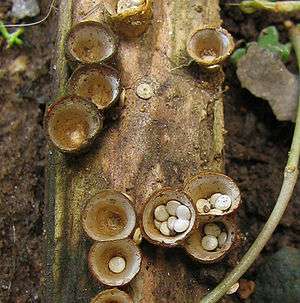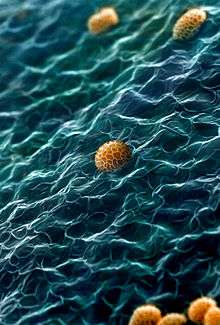Peridium
The peridium is the protective layer that encloses a mass of spores in fungi.[1] This outer covering is a distinctive feature of gasteroid fungi.


Description
Depending on the species, the peridium may vary from being paper-thin to thick and rubbery or even hard. Typically, peridia consist of one to three layers. If there is only a single layer, it is called a peridium. If two layers are present, the outer layer is called the exoperidium and the inner layer the endoperidium. If three layers are present, they are the exoperidium, the mesoperidium and the endoperidium.[2]
In the simplest subterranean forms, the peridium remains closed until the spores are mature, and even then shows no special arrangement for dehiscence or opening, but has to decay before the spores are liberated.[3]
Puffballs
For most fungi, the peridium is ornamented with scales or spines. In species that become raised above ground during their development, generally known as the "puffballs", the peridium is usually differentiated into two or more layers, where the outer layer is usually resolved into warts or spines. In contrast, the inner layer remains continuous and smooth to preserve the spores. Sometimes, as in the case of Geaster, the number of layers is greater, and the exoperidium eventually splits from the apex into a variable number of pointed portions. However, the inner layer remains intact by a definite aperture at the apex.[4]
Usage
The peridium is often given a specific name in particular species of fungi. For example, the peridium of the sub-family Phalloideae is called a volva. The peridium can also refer to the outer "nest" of a bird's-nest fungus.[8]
References
- British Fungus – Flora, by George Massee; page 6; Published by George Bell and Sons, 1892
- Blackwell, Meredith; Alexopoulos, Constantine John; Mims, Charles W. (1996). Introductory mycology. New York: Wiley. p. 544. ISBN 0-471-52229-5.
- "Fungi Mycetozoa and Bacteria". Eng. Ed. "A Monograph of the British Gastromycetes", Annals of Botany, vol. iv. 1889.
- British Fungus – Flora: A Classified Textbook of Mycology; By George Massee; Published by George Bell and Sons, 1892; Item notes: v.1; Original from Harvard University; Digitized Jun 1, 2007
- A Field Guide to Mushrooms: North America; By Vera B. McKnight, Roger Tory Peterson, National Audubon Society, National Wildlife Federation; page 362; Illustrated by Vera B. McKnight; Published by HMCo Field Guides, 1998; ISBN 0-395-91090-0, ISBN 978-0-395-91090-0
- The Genera of Fungi; By Frederic Edward Clements; Published by The H. W. Wilson company, 1909; Original from the University of Michigan; page 195
- Mushrooms Demystified: A Comprehensive Guide to the Fleshy Fungi; By David Arora; page 708; Published by Ten Speed Press, 1986
- Botany Illustrated: Introduction to Plants, Major Groups, Flowering Plant Families; By Janice Glimn-Lacy, Peter B. Kaufman; page 53; Published by Birkhäuser, 2006; ISBN 0-387-28870-8, ISBN 978-0-387-28870-3